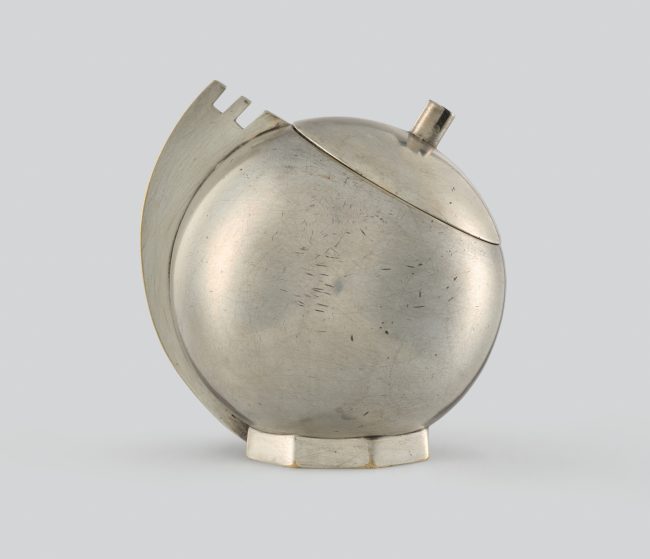
„Sphere” sugar bowl
The sugar bowl was produced around 1935 at the manufacturing plant of the jointstock company Metal Factories Norblin, Buch Bros & T. Werner. It was designed by the sculptress and metalwork artist Julia Keilowa (1902–1943). The artist assumed that the beauty of an object originated from the harmony of form, function and material.
Her work with metal was driven by the pursuit of uniting decoration and structure. Her designs were characterised by refined elegance, which resulted from restraint and precise combination of solids: spheres, cones, cylinders and cubes, which formed a balanced composition. Keilowa often used gentle curves and fan-like diverging windings. In the 1930s, the artist collaborated with the major plating companies in Warsaw: Norblin, Fraget, Henneberg Brothers, Keilowa created industrial designs that emanated the Art Deco style.
With Poland’s regained independence after World War I (1914–1918) – after a period when the country remained divided between Russia, Prussia and Austria as a result of Partitions between 1772 and 1795 – the plating companies in the capital city were cut off from the Russian market, which had provided high and stable financial income prior to 1914. In the initial period, attempts were made to compensate for the losses by seeking new international clients. Yet, such pursuits did not yield expected results. Under the impact of inflation and decreasing demand, the companies reduced the volume of production and the range of products on offer, they also stopped modernising their designs. It was only the profound economic crisis triggered by the Great Depression in 1929 that motivated the owners of Warsaw companies to introduce new designs.
At the time, the decorative geometrically-flavoured Art Deco style was in vogue in Europe and America. There was a chance that items emanating such a style would meet the tastes and expectations of the clients. The commercial success of a new offer could contribute to combatting the financial recession. Therefore, companies were on the lookout for designers to create attractive models for mass production. The first company to collaborate with Julia Keilowa, a young promising graduate of the Warsaw School of Fine Arts, was Fraget. Later, she was approached by Norblin and the Henneberg Brothers. The artist created different designs for each of the companies, yet they were all heavily geometrical and featured simplified purist forms.
Plated silverware by Keilowa, which follows such aesthetics, is ranked today among Polish design classics. The items also gained recognition among her contemporaries. In 1937, Fraget was awarded two Golden Medals at the International Exposition of Art and Technology in Modern Life in Paris. Plated silverware designed by the artist also formed part of the crockery of the MS Piłsudski ocean liner – the passenger ship that served the connection between Gdynia and New York, called a floating salon given its decoration and equipment designed by the most outstanding Polish designers. Keilowa’s metalwork was featured and discussed in the press, and her designs undoubtedly contributed to the growing prestige of Warsaw plated silverware companies.
Sphere sugar bowl
DESIGNED BY JULIA KEILOWA, PRODUCED BY METAL PLANT JOINTSTOCK
COMPANY NORBLIN, THE BUCH BROS. AND T. WERNER
WARSAW; C. 1935
SILVER-PLATED, DIE-STAMPED, CAST BRASS
MHW 22054
11,8 × 11,7 × 10,6 CM
Image licensed under: ![]()
